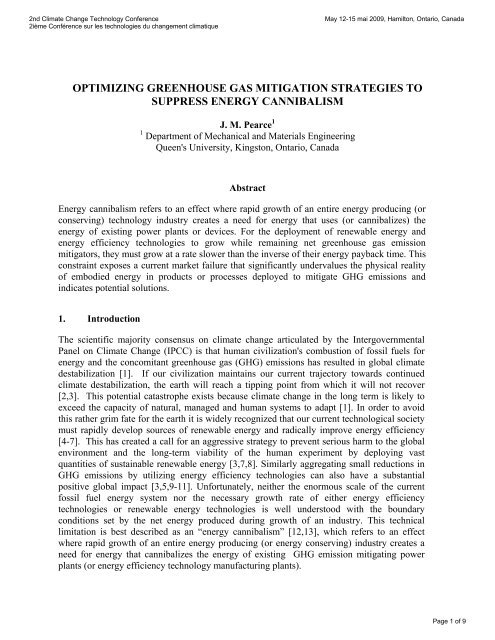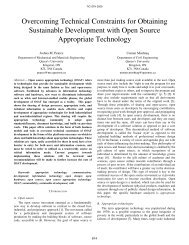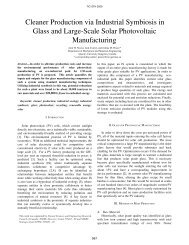Optimizing greenhouse gas mitigation strategies to suppress energy
Optimizing greenhouse gas mitigation strategies to suppress energy
Optimizing greenhouse gas mitigation strategies to suppress energy
You also want an ePaper? Increase the reach of your titles
YUMPU automatically turns print PDFs into web optimized ePapers that Google loves.
2nd Climate Change Technology Conference<br />
2ième Conférence sur les technologies du changement climatique<br />
May 12-15 mai 2009, Hamil<strong>to</strong>n, Ontario, Canada<br />
OPTIMIZING GREENHOUSE GAS MITIGATION STRATEGIES TO<br />
SUPPRESS ENERGY CANNIBALISM<br />
J. M. Pearce 1<br />
1 Department of Mechanical and Materials Engineering<br />
Queen's University, Kings<strong>to</strong>n, Ontario, Canada<br />
Abstract<br />
Energy cannibalism refers <strong>to</strong> an effect where rapid growth of an entire <strong>energy</strong> producing (or<br />
conserving) technology industry creates a need for <strong>energy</strong> that uses (or cannibalizes) the<br />
<strong>energy</strong> of existing power plants or devices. For the deployment of renewable <strong>energy</strong> and<br />
<strong>energy</strong> efficiency technologies <strong>to</strong> grow while remaining net <strong>greenhouse</strong> <strong>gas</strong> emission<br />
mitiga<strong>to</strong>rs, they must grow at a rate slower than the inverse of their <strong>energy</strong> payback time. This<br />
constraint exposes a current market failure that significantly undervalues the physical reality<br />
of embodied <strong>energy</strong> in products or processes deployed <strong>to</strong> mitigate GHG emissions and<br />
indicates potential solutions.<br />
1. Introduction<br />
The scientific majority consensus on climate change articulated by the Intergovernmental<br />
Panel on Climate Change (IPCC) is that human civilization's combustion of fossil fuels for<br />
<strong>energy</strong> and the concomitant <strong>greenhouse</strong> <strong>gas</strong> (GHG) emissions has resulted in global climate<br />
destabilization [1]. If our civilization maintains our current trajec<strong>to</strong>ry <strong>to</strong>wards continued<br />
climate destabilization, the earth will reach a tipping point from which it will not recover<br />
[2,3]. This potential catastrophe exists because climate change in the long term is likely <strong>to</strong><br />
exceed the capacity of natural, managed and human systems <strong>to</strong> adapt [1]. In order <strong>to</strong> avoid<br />
this rather grim fate for the earth it is widely recognized that our current technological society<br />
must rapidly develop sources of renewable <strong>energy</strong> and radically improve <strong>energy</strong> efficiency<br />
[4-7]. This has created a call for an aggressive strategy <strong>to</strong> prevent serious harm <strong>to</strong> the global<br />
environment and the long-term viability of the human experiment by deploying vast<br />
quantities of sustainable renewable <strong>energy</strong> [3,7,8]. Similarly aggregating small reductions in<br />
GHG emissions by utilizing <strong>energy</strong> efficiency technologies can also have a substantial<br />
positive global impact [3,5,9-11]. Unfortunately, neither the enormous scale of the current<br />
fossil fuel <strong>energy</strong> system nor the necessary growth rate of either <strong>energy</strong> efficiency<br />
technologies or renewable <strong>energy</strong> technologies is well unders<strong>to</strong>od with the boundary<br />
conditions set by the net <strong>energy</strong> produced during growth of an industry. This technical<br />
limitation is best described as an “<strong>energy</strong> cannibalism” [12,13], which refers <strong>to</strong> an effect<br />
where rapid growth of an entire <strong>energy</strong> producing (or <strong>energy</strong> conserving) industry creates a<br />
need for <strong>energy</strong> that cannibalizes the <strong>energy</strong> of existing GHG emission mitigating power<br />
plants (or <strong>energy</strong> efficiency technology manufacturing plants).<br />
Page 1 of 9
2nd Climate Change Technology Conference<br />
2ième Conférence sur les technologies du changement climatique<br />
May 12-15 mai 2009, Hamil<strong>to</strong>n, Ontario, Canada<br />
In this paper: i) a generalized process will be derived for determining the <strong>energy</strong> cannibalism<br />
for a given <strong>energy</strong> technology, ii) the limits on the growth rate set by <strong>energy</strong> cannibalism will<br />
be discussed in the context of climate stabilization, iii) complications <strong>to</strong> future projects of net<br />
emissions will be outlined, iv) the scale of the <strong>energy</strong> problem will be quantified and the<br />
necessary growth rates will be generalized for GHG emission mitigating <strong>energy</strong> technology<br />
(ET – for both renewable <strong>energy</strong> producing and <strong>energy</strong> conserving technologies). Finally, the<br />
impact the concept of <strong>energy</strong> cannibalism will have on the economics of climate change<br />
<strong>mitigation</strong> will be discussed. Conclusions and recommendations are made from the analysis<br />
<strong>to</strong> assist decision makers in optimizing deployment of technologies on large scales <strong>to</strong> reduce<br />
GHG emissions <strong>to</strong> safe stable levels.<br />
2. Energy cannibalization due <strong>to</strong> rapid growth<br />
2.1 Energy payback time and GHG emission conservation payback time<br />
Due <strong>to</strong> the contamination of the current <strong>energy</strong> mix with fossil fuel combustion, all current<br />
technologies are dependent <strong>to</strong> some degree on fossil fuel <strong>energy</strong> and thus also contribute <strong>to</strong><br />
GHG emissions. In order for an ET <strong>to</strong> have a net negative impact on GHG emissions of the<br />
<strong>energy</strong> supply, first it must produce enough emission-less <strong>energy</strong> or conserve enough <strong>energy</strong><br />
<strong>to</strong> offset the emissions that it is responsible for, and then it must continue <strong>to</strong> produce <strong>energy</strong><br />
or conserve <strong>energy</strong> <strong>to</strong> offset emissions from existing or potential fossil fuel plants. Many<br />
technologies are candidates for meeting these requirements such as renewable sources of<br />
<strong>energy</strong> (wind power, solar power, microhydro, etc.) and <strong>energy</strong> conserving technologies (e.g.<br />
solid state lighting, insulation, Energy Star appliances, etc.). These requirements, however,<br />
can become challenging in view of rapid growth because the construction of additional ET<br />
production plants <strong>to</strong> enable the rapid growth rate, creates emissions that cannibalize the GHG<br />
<strong>mitigation</strong> potential of all the ET plants viewed as a group.<br />
To illustrate this point it is helpful <strong>to</strong> view all ET plants of a given type as a single aggregate<br />
plant or ensemble and look at the ensemble's ability <strong>to</strong> mitigate emissions as it grows [13].<br />
This ability is first dependent on the <strong>energy</strong> payback time (t EP ) of the plant, or the amount of<br />
time it takes for a given device <strong>to</strong> produce (or conserve) as much <strong>energy</strong> as it <strong>to</strong>ok <strong>to</strong><br />
construct. For a generic <strong>energy</strong> producing technology (or <strong>energy</strong> conserving technology), an<br />
installed <strong>to</strong>tal capacity, C T (in GW), produces (or conserves):<br />
N<br />
E T<br />
=tC T<br />
=t∑ C n (1)<br />
n=1<br />
of <strong>energy</strong> per year, where t is the time the plant is running at capacity in hours in a year, C n is<br />
the capacity of an individual ET and N is the <strong>to</strong>tal number of ETs.<br />
If we assume that in the same year the industry of that technology grows at a rate, r, it<br />
will produce an additional capacity of rC T . It should be made clear here that the analysis is<br />
based on a standard unit of time – a year. The amount of <strong>energy</strong> that the industry produces (or<br />
conserves) is obtained by multiplying by the time and is thus rC T t. In order <strong>to</strong> keep the<br />
Page 2 of 9
2nd Climate Change Technology Conference<br />
2ième Conférence sur les technologies du changement climatique<br />
May 12-15 mai 2009, Hamil<strong>to</strong>n, Ontario, Canada<br />
derivation transparent, it is assumed that the additional capacity does not produce (or<br />
conserve) its <strong>energy</strong>, rC T t, in that year but only in subsequent years. The time that the GHG<br />
emission reduction technology takes <strong>to</strong> pay for itself in terms of <strong>energy</strong> it needs over its life<br />
cycle, or the t EP , is given by embodied <strong>energy</strong> invested (over the entire life cycle), E E , divided<br />
by <strong>energy</strong> produced (or <strong>energy</strong> saved), E P/S . Thus t EP , as measured in years, is:<br />
t EP<br />
= E E<br />
E P/S (2)<br />
An identical analysis can be completed for GHG emissions. If a given ET causes GHG<br />
emissions during its manufacture and use, it must operate for a finite amount of time <strong>to</strong><br />
achieve climate forcing neutrality.<br />
2.2 Energy cannibalism<br />
The <strong>energy</strong> needed for the growth of the entire ET ensemble is given by the cannibalistic<br />
<strong>energy</strong>, E Can :<br />
E Can<br />
= E E<br />
E P/S<br />
rC T<br />
t (3)<br />
Regardless if the technology is an <strong>energy</strong> producer or conserver, the technology ensemble<br />
will not produce any net <strong>energy</strong> if the cannibalistic <strong>energy</strong> is equivalent <strong>to</strong> the <strong>to</strong>tal <strong>energy</strong><br />
produced. So by setting equation (1) equal <strong>to</strong> (3) and simplifies <strong>to</strong> set equation (2) equal <strong>to</strong> the<br />
inverse of the growth rate:<br />
E E<br />
E P/S<br />
= 1 r = t EP (4)<br />
Equation 4 shows that the growth rate of an ET industry may not exceed the reciprocal of the<br />
<strong>energy</strong> payback time <strong>to</strong> have a positive net <strong>energy</strong>. For example, if the <strong>energy</strong> payback time is<br />
4 years and the capacity growth of either an ET ensemble is 25%, no net <strong>energy</strong> is produced<br />
and no GHG emissions are offset. This is because the same analysis is also true for GHG<br />
emissions. The embodied GHG emitted in order <strong>to</strong> provide for the ET divided by the<br />
emissions offset every year must be equal <strong>to</strong> one over the growth rate of the ET simply <strong>to</strong><br />
break even. This cannibalism of <strong>energy</strong> for new ETs has a profound effect on their ability <strong>to</strong><br />
assist in the <strong>mitigation</strong> of GHG emissions.<br />
It should also be noted here that the <strong>energy</strong> payback times for a given ET are dependent on<br />
the exact deployment. For example, a wind genera<strong>to</strong>r will have a much faster t EP and thus<br />
allow for a higher growth rate if deployed in a region with high average wind speeds, while<br />
the same genera<strong>to</strong>r deployed in a less attractive location will have a lower t EP . Similarly, a<br />
high efficiency solid-state lighting system will have a faster payback if it is installed in a<br />
location that demands constant use (e.g. an enclosed stairway or in emergency exit signs)<br />
Page 3 of 9
2nd Climate Change Technology Conference<br />
2ième Conférence sur les technologies du changement climatique<br />
May 12-15 mai 2009, Hamil<strong>to</strong>n, Ontario, Canada<br />
versus a system installed in a building that has relatively infrequent use such as an<br />
entertainment complex or church.<br />
3. Energy cannibalism sets the speed limit for growth<br />
The restrictions of <strong>energy</strong> cannibalism are not limited <strong>to</strong> complex 'hi-tech' devices; even<br />
mundane technologies such as home insulation have a maximum climate neutral growth rate.<br />
The r limit set by <strong>energy</strong> cannibalism for insulation, as for many ETs, not only varies widely<br />
because it is highly geographically dependent (e.g. weather, local <strong>energy</strong> sources, and human<br />
behavior), but also has largely not been determined. Some alternative <strong>energy</strong> technologies,<br />
such as solar pho<strong>to</strong>voltaic cells, have considerable literature dedicated <strong>to</strong> life cycle analyses<br />
(LCAs) and embodied GHG emissions, but the majority of <strong>energy</strong> conserving or producing<br />
technologies have not been scrutinized as thoroughly. To combat GHG emissions on an<br />
appropriate mass scale, full LCAs and t EP s must be calculated for all candidate technologies.<br />
For leaders <strong>to</strong> make informed, intelligent decisions about which ETs <strong>to</strong> deploy on a large<br />
scale this data is imperative.<br />
This work becomes increasingly important as civilization approaches the tipping point in<br />
climate stabilization. If humanity wishes <strong>to</strong> preserve a planet similar <strong>to</strong> that on which<br />
civilization developed and <strong>to</strong> which life on Earth is adapted, paleoclimate evidence and<br />
ongoing climate change suggest that atmospheric CO 2 concentration will need <strong>to</strong> be reduced<br />
from its current 385 ppm <strong>to</strong> at most 350 ppm [2]. This CO 2 concentration is determined by a<br />
limit of 1°C global warming (relative <strong>to</strong> 2000, 1.7°C relative <strong>to</strong> pre-industrial time), aiming <strong>to</strong><br />
avoid practically irreversible ice sheet and species loss [14]. This 1°C limit, with nominal<br />
climate sensitivity of 3⁄4°C per W/m 2 and plausible control of other GHGs [15], implies<br />
maximum CO 2 concentration of approximately 450 ppm [14], which must not be crossed<br />
before stabilizing at a lower concentration. This physical limit <strong>to</strong> global CO 2 concentration<br />
places enormous boundary conditions on the ability <strong>to</strong> deploy any ETs on a scale necessary <strong>to</strong><br />
reduce fossil fuel use and drive the CO 2 concentration below 350 ppm. Given the current<br />
trend of increased <strong>energy</strong> use for economic development, additional GHG emissions<br />
necessary for the massive growth of ETs <strong>to</strong> offset fossil fuels may not be <strong>to</strong>lerable. This<br />
boundary condition is a very complex moving target, however, because of the inherent<br />
instability of <strong>energy</strong> prices in the current market system. Recent increases in <strong>energy</strong> costs and<br />
particularly the cost of <strong>gas</strong>oline had remarkable effects on both demand destruction, but also<br />
the entire economy. Similarly demand destruction, whether by economic hardship, lack of<br />
available credit, or efficiency improvements, decreases <strong>energy</strong> costs and below a certain<br />
threshold can increase <strong>energy</strong> use.<br />
Thus, <strong>to</strong> prevent additional climate forcing while mass deploying ETs on the global scale the<br />
condition of equation (4) for the aggregated for all ETs must be met. This effectively sets a<br />
limit on growth of the entire body of ETs while ensuring that the net <strong>energy</strong> remains positive.<br />
This limit in the growth rate of non-GHG emitting <strong>energy</strong> sources also sets the limit for the<br />
time <strong>to</strong> which the anthropogenic climate forcing can be stabilized without radically shifting<br />
human economies. Considerable further work is needed <strong>to</strong> quantify this limit by calculating<br />
t EP s of all potential ETs <strong>to</strong> determine the optimal mix of technologies for driving down CO 2<br />
concentration below 350 ppm. This appreciable work needs <strong>to</strong> be developed quickly on a<br />
Page 4 of 9
2nd Climate Change Technology Conference<br />
2ième Conférence sur les technologies du changement climatique<br />
May 12-15 mai 2009, Hamil<strong>to</strong>n, Ontario, Canada<br />
global scale as each passing year makes the problem of replacing fossil fuels before reaching<br />
the 450ppm absolute limit of CO 2 concentration that much more challenging.<br />
4. Complications in quantifying the effects of <strong>energy</strong> cannibalism<br />
The cannibalization effect, however, is more complicated than the simple yet vast results<br />
above would indicate. There are both positive and negative effects.<br />
First, with each ET plant constructed, the embodied GHG emissions of the next plant will be<br />
reduced because the fraction of non-fossil fuel based <strong>energy</strong> has increased. As the embodied<br />
GHG emissions is decreased and the effective growth rate can be increased. It is also likely<br />
that sources of <strong>energy</strong> that have lower mass CO 2 -eq. per unit <strong>energy</strong> rates than fossil fuels<br />
will be deployed at an expanding rate as economies of scale drive down cost as production<br />
increases (e.g. solar pho<strong>to</strong>voltaic cells) [16]. This will speed the decrease in the embodied<br />
GHG emissions for any type of ET ensemble. Similarly for each ET device deployed that<br />
conserves <strong>energy</strong> the <strong>to</strong>tal amount of <strong>energy</strong> needed is reduced, which reduces the necessary r<br />
<strong>to</strong> meet a climate neutral <strong>energy</strong> state at a specific point in time. In addition, as the <strong>to</strong>tal<br />
demand is reduced the least efficient conventional plants are taken off line. This further<br />
decreases the embodied <strong>energy</strong> of future ETs. Thus the growth rate needed for stabilization of<br />
the earth's climate can be decreased with a suitable deployment of ETs.<br />
Second, as we deplete the dwindling supplies of fossil fuels the embodied <strong>energy</strong> and<br />
emissions <strong>to</strong> extract and use these sources increases. We must drill deeper, uncover more<br />
earth, and explore increasingly less hospitable terri<strong>to</strong>ries <strong>to</strong> capture declining supplies of both<br />
fuels used <strong>to</strong> form ETs and materials used <strong>to</strong> make ETs. For example, Cleveland and<br />
Costanza studied the <strong>energy</strong> return on <strong>energy</strong> invested (EROI) of natural <strong>gas</strong> production in<br />
Louisiana through early production, peak, and in<strong>to</strong> decline [17]. They found that the EROI<br />
decline rate of a resource as it is dwindling is both linear and remarkably steep. The EROI<br />
plunged from maximum <strong>to</strong> minimum in only the last 25% of the <strong>energy</strong> extracted [17]. As the<br />
EROI decreases for fossil fuel <strong>energy</strong> used <strong>to</strong> supply ETs, the <strong>energy</strong> payback time of the ETs<br />
increase, and the embodied <strong>energy</strong> and emissions both increase. This is also the case if<br />
nuclear <strong>energy</strong> is used <strong>to</strong> provide the embodied <strong>energy</strong> of ETs because as more nuclear<br />
<strong>energy</strong> is utilized the high grade ores are depleted and less concentrated ore, which demands<br />
greater embodied <strong>energy</strong> <strong>to</strong> process is required [12]. The further we deplete the given<br />
resource the worse the effect. Thus the limit of the growth rate of ETs needed for stabilization<br />
of the earth's climate would be decreased. In an age where the production of the supplies of<br />
particular fossil fuels are reaching their peak in an ever growing list of regions and the global<br />
peak in oil extraction appears near, this concept becomes increasingly relevant <strong>to</strong> <strong>energy</strong><br />
payback calculations. Full vetting of this concept along with the beneficial effect discussed<br />
previously, will need <strong>to</strong> be completed in the future as all ET candidates are identified and full<br />
LCAs are completed for each geographical location.<br />
5. Necessary renewable <strong>energy</strong> rates of expansion<br />
5.1 Replacing existing fossil fuel <strong>energy</strong> infrastructure<br />
Page 5 of 9
2nd Climate Change Technology Conference<br />
2ième Conférence sur les technologies du changement climatique<br />
May 12-15 mai 2009, Hamil<strong>to</strong>n, Ontario, Canada<br />
The <strong>to</strong>tal final <strong>energy</strong> consumption for 2006 was 8,150 millions <strong>to</strong>ns of oil equivalent, of<br />
which fossil fuels made up about 79% [18]. Fortunately, the entire <strong>energy</strong> infrastructure does<br />
not need <strong>to</strong> be replaced. To stall climate change, current global GHG emissions must be cut<br />
by about 60% [15]. Thus, if the non-GHG emitting <strong>energy</strong> were <strong>to</strong> be supplied by any of the<br />
sustainable sources of <strong>energy</strong> (e.g. solar, wind, small hydro, geothermal, etc.) or a<br />
combination, an additional 3,863 millions <strong>to</strong>ns of oil equivalent of ETs would need <strong>to</strong> be<br />
produced per year from these sources <strong>to</strong> meet <strong>to</strong>day’s <strong>energy</strong> needs while preventing<br />
additional climate change. Currently, renewable <strong>energy</strong> represents 18% of global <strong>energy</strong><br />
consumption, but the relatively constrained supplies of traditional biomass and large<br />
hydropower make up about 16% [18]. New sources of renewable <strong>energy</strong> such as small hydro,<br />
modern biomass, wind, solar, geothermal, and biofuels provide only 2.4% (196 million <strong>to</strong>ns<br />
of oil equivalent). Thus <strong>to</strong> reach 3,863 millions <strong>to</strong>ns of oil equivalent of ETs by 2050 and the<br />
aggregate of the renewable ETs will need <strong>to</strong> grow by more than 7% annually. In light of the<br />
recent increases in production of these technologies (e.g. solar pho<strong>to</strong>voltaic at 50% per year<br />
[18]) simply obtaining that level of growth is not the primary constraint even though the<br />
magnitude of the quantities themselves are substantial.<br />
5.2 Rate of <strong>energy</strong> demand increase<br />
The construction of this much ET infrastructure is a formidable challenge, but the GHG<br />
emission induced climate challenge is being significantly complicated by rapid increases in<br />
<strong>energy</strong> needs as developing countries elevate themselves out of poverty and the wealthy<br />
throughout the world continue <strong>to</strong> increase the consumption of remaining fossil fuel supplies at<br />
an as<strong>to</strong>nishing rate. The United Nations forecasts the global population will reach 8.5 billion<br />
by 2050 [19] with 80% of this increased population expected <strong>to</strong> reside in <strong>energy</strong>-intensive<br />
urbanized areas. This increase and shift in demographics is expected <strong>to</strong> lead <strong>to</strong> rapid growth<br />
in global <strong>energy</strong> demand. The need for a new non-fossil fuel-based <strong>energy</strong> source is evident<br />
from comparing the standard of living, which is dependent on <strong>energy</strong>, in the most developed<br />
countries and developing countries. Although the population of the developing world is five<br />
times that of developed nations, they consume less than 40% of the world’s <strong>energy</strong> supply<br />
[20]. Therefore, the climate challenge is being significantly complicated with the developing<br />
world’s continuing transition in<strong>to</strong> a standard of living similar <strong>to</strong> those in the industrialized<br />
nations that require more <strong>energy</strong> consumption.<br />
Growth rate limits can be obtained if renewable <strong>energy</strong> alone is considered as a means <strong>to</strong><br />
protect the planet by reducing fossil fuel-related <strong>greenhouse</strong> <strong>gas</strong> emissions. First <strong>to</strong> cover the<br />
non-acceptable current fossil fuel production of <strong>energy</strong> as discussed in section 5.1, 7% growth<br />
is needed for the next 40 years in renewable <strong>energy</strong> sources. Thus the <strong>energy</strong> payback time is<br />
limited <strong>to</strong> about 13 years by the <strong>energy</strong> neutral growth rate. This rate is dictated by <strong>energy</strong><br />
cannibalism for the replacement of existing unacceptable fossil fuel infrastructure. Next,<br />
growth in <strong>energy</strong> demand must be considered. The World Energy Council projects that in a<br />
high growth world in which economic growth and <strong>energy</strong> consumption steadily increases, the<br />
global primary <strong>energy</strong> consumption could reach 24.8 Giga<strong>to</strong>ns oil equivalent (G<strong>to</strong>e) by 2050<br />
[20]. It should be noted here that these projections may be high due <strong>to</strong> the current global<br />
economic recession and lack of confidence in a debt based economy, but they are the best<br />
Page 6 of 9
2nd Climate Change Technology Conference<br />
2ième Conférence sur les technologies du changement climatique<br />
May 12-15 mai 2009, Hamil<strong>to</strong>n, Ontario, Canada<br />
available source of estimations. Thus the range of growth rate limits and <strong>energy</strong> payback<br />
times can be set by no growth case and this maximum expected growth. For the high growth<br />
case, this enormous increase in <strong>energy</strong> demand represents a major challenge <strong>to</strong> current <strong>energy</strong><br />
infrastructure. Not only must the magnitude of the <strong>energy</strong> demands be met, but they must be<br />
met in a way which will avoid further CO 2 forcing of the climate system by overcoming the<br />
<strong>energy</strong> cannibalization effect. In this far more challenging case of both limiting fossil fuel<br />
combustion <strong>to</strong> 40% of the present, while allowing for growth in <strong>energy</strong> use <strong>to</strong> 24.8 G<strong>to</strong>e,<br />
renewable <strong>energy</strong> sources must increase by more than a fac<strong>to</strong>r of 100 by 2050. To do this,<br />
renewable <strong>energy</strong> sources will need <strong>to</strong> increase by 12% per year for the next 40 years. Energy<br />
cannibalism thus demands that the growth of the renewable <strong>energy</strong> sec<strong>to</strong>r be limited in<br />
aggregate <strong>to</strong> payback times of about 8 years. For many of the ETs under consideration this is<br />
not primarily a problem. For example, solar pho<strong>to</strong>voltaic cells generally have payback times<br />
under 5 years with most less than 2 years [21]. However, the balance of systems, or the way<br />
in which the solar pho<strong>to</strong>voltaic cells are deployed, e.g. a high canopy system consisting of a<br />
large quantity of steel can increase the payback time substantially.<br />
6. Discussion<br />
As the world focuses on methods <strong>to</strong> reduce fossil fuel combustion and the concomitant global<br />
climate destabilization, policy is often driven by concern over the economic costs for a given<br />
reduction in <strong>greenhouse</strong> <strong>gas</strong> emissions. As the climate system approaches a tipping point,<br />
such economic considerations must come behind physical laws. There are many examples of<br />
ETs that perform well from a net <strong>energy</strong> perspective, but fail <strong>to</strong> provide an attractive return on<br />
economic investments. High efficiency window retrofits, for example, have t EP of less than a<br />
year for many regions, but have economic paybacks measuring in years or even decades.<br />
Similarly, methods <strong>to</strong> reduce GHG emissions economically (as with highly subsidized nuclear<br />
power) may not make sense in high growth conditions needed (and lower ore grades are used)<br />
<strong>to</strong> supplant fossil fuels when <strong>energy</strong> cannibalism is considered) [12]. These results indicate a<br />
need for a move <strong>to</strong>wards of a global “<strong>energy</strong> economy” - an economy based on a real physical<br />
value of <strong>energy</strong> rather than on a subjective valuation of worth, in order <strong>to</strong> make informed<br />
decisions <strong>to</strong> ensure a stable climate for all nations and the biosphere. This can be<br />
accomplished using a number of mechanisms such as carbon credits [22], carbon trading [23],<br />
output-based allocations [24], carbon taxes [25], a shift <strong>to</strong> an <strong>energy</strong>-based economic system,<br />
and other methods discussed elsewhere including this conference. Regardless of the system<br />
used, the economic costs of <strong>energy</strong> need <strong>to</strong> be better aligned with the physical reality of<br />
<strong>energy</strong>. This challenges the market economy <strong>to</strong> adapt <strong>to</strong> fix the current market failure, which<br />
has driven investments in inefficient and polluting technologies for decades.<br />
7. Conclusions<br />
This paper has furthered preliminary work, which has shown that the GHG emission neutral<br />
growth rate of both <strong>energy</strong> conserving technologies and renewable <strong>energy</strong> technologies are<br />
constrained by the effects of <strong>energy</strong> cannibalism. To grow at the 7-12% rates needed <strong>to</strong><br />
stabilize the climate under <strong>energy</strong> demand increases, while remaining net GHG emission<br />
reducers, all ETs must grow at a rate slower than the inverse of their payback time (in<br />
aggregate
2nd Climate Change Technology Conference<br />
2ième Conférence sur les technologies du changement climatique<br />
May 12-15 mai 2009, Hamil<strong>to</strong>n, Ontario, Canada<br />
need <strong>to</strong> be developed for all ETs so that the technologies with the fastest <strong>energy</strong> payback<br />
times can be deployed first in the appropriate regions. In addition, every effort should be<br />
made <strong>to</strong> increase the efficiency, and thus <strong>energy</strong> produced (or conserved) of all candidate ETs<br />
by improving material choices, manufacturing techniques, and reducing embodied <strong>energy</strong> of<br />
transportation by encouraging regional/local manufacture. It is imperative that decision<br />
makers begin <strong>to</strong> focus on the real <strong>energy</strong> payback times and growth rates <strong>to</strong> combat global<br />
climate destabilization rather than rely on simple economics, which is often independent of<br />
physical reality. ETs that overcome <strong>energy</strong> cannibalism by becoming <strong>energy</strong> breeders, which<br />
produce many time their embodied energies, must be supported by policy <strong>to</strong> deploy them in<br />
mass quantities within the next 40 years <strong>to</strong> stave off the worst of climate destabilization.<br />
8. References<br />
[1] Intergovernmental Panel on Climate Change (IPCC), “Climate Change 2007”, S.<br />
Solomon et al., Eds., 2007, Cambridge Univ. Press, New York.<br />
[2] Hansen, J., Sa<strong>to</strong>, M., Kharecha, P., Beerling, D., Masson-Delmotte, V., Pagani, M.,<br />
Raymo, M., Royer, D. L., Zachos, J. C. (2008), “Target atmospheric CO 2 : Where<br />
should humanity aim?”, The Open Atmospheric Science Journal, Vol. 2, 2008<br />
pp.217-231.<br />
[3] Hoffert, M. I., Caldeira, K., Benford, G., Criswell, D.R., Green, C., Herzog, H., Jain,<br />
A.K., Kheshgi, H.S., Lackner, K.S., Lewis, J.S., Lightfoot, H.D., Manheimer, W.,<br />
Mankins, J.C., Mauel, M.E., Perkins, L.J., Schlesinger, M.E.,Volk, T., and Wigley,<br />
T.M.L., “Advanced Technology Paths <strong>to</strong> Global Climate Stability: Energy for a<br />
Greenhouse Planet”, Science, Vol. 298, 2002, pp. 981-987.<br />
[4] Curry, T.E., Ansolabehere, S., and Herzog, H., “A Survey of Public Attitudes <strong>to</strong>wards<br />
Climate Change and Climate Change Mitigation Technologies in the United States:<br />
Analyses of 2006” 2007, Pub. No. LFEE 2007-01 WP MIT Carbon Sequest. Initiative.<br />
[5] Pacala, S.and Socolow, R. “Stabilization Wedges: Solving the Climate Problem for the<br />
Next 50 Years with Current Technologies”, Science, Vol. 305. No. 5686, 2004, pp.<br />
968-972.<br />
[6] Leiserowitz, A. “Climate Change Risk Perception and Policy Preferences: The Role of<br />
Affect, Imagery, and Values”, Climate Change, Vol. 77, No. 1-2, 2006, pp. 45-72.<br />
[7] Pearce, J. M. “Pho<strong>to</strong>voltaics – A Path <strong>to</strong> Sustainable Futures”, Futures, Vol. 34, No. 7,<br />
2002, pp. 663-674.<br />
[8] Kutscher, C.F. (edi<strong>to</strong>r) “Tackling Climate Change in the U.S. Tackling Climate Change<br />
in the U.S. Potential Carbon Emissions Reductions Efficiency and Carbon Emissions<br />
Reductions from Energy Efficiency and Renewable Energy by 2030”, 2007. American<br />
Solar Energy Society.<br />
[9] Pearce, J. and Russill, C. “Interdisciplinary Environmental Education: Communicating<br />
and Applying Energy Efficiency for Sustainability”, Applied Environmental Education<br />
and Communication, Vol. 4, No. 1, 2005, pp. 65-72.<br />
[10] Pearce J. M. and Miller, L. L. “Energy Service Companies as a Component of a<br />
Comprehensive University Sustainability Strategy”, International Journal of<br />
Sustainability in Higher Education, Vol. 7, No. 1, 2006, pp. 16-33.<br />
Page 8 of 9
2nd Climate Change Technology Conference<br />
2ième Conférence sur les technologies du changement climatique<br />
May 12-15 mai 2009, Hamil<strong>to</strong>n, Ontario, Canada<br />
[11] Pearce, J. M., Johnson, S. J., and Grant, G.B. “3D-Mapping Optimization of Embodied<br />
Energy of Transportation”, Resources, Conservation and Recycling, Vol. 51, 2007, pp.<br />
435–453.<br />
[12] Pearce J. M. “Thermodynamic Limitations <strong>to</strong> Nuclear Energy Deployment as a<br />
Greenhouse Gas Mitigation Technology”, International Journal of Nuclear Governance,<br />
Economy and Ecology, Vol. 2, No. 1, 2008, pp. 113-130.<br />
[13] Pearce, J.M. “Limitations of Greenhouse Gas Mitigation Technologies Set by Rapid<br />
Growth and Energy Cannibalism” Climate 2008/Klima 2008.<br />
Available: http://www.climate2008.net/?a1=pap&cat=1&e=61<br />
[14] Hansen, J., Mki. Sa<strong>to</strong>, R. Ruedy, P. Kharecha, A. Lacis, R.L. Miller, L. Nazarenko, K.<br />
Lo, G.A. Schmidt, G. Russell, I. Aleinov, S. Bauer, E. Baum, B. Cairns, V. Canu<strong>to</strong>, M.<br />
Chandler, Y. Cheng, A. Cohen, A. Del Genio, G. Faluvegi, E. Fleming, A. Friend, T.<br />
Hall, C. Jackman, J. Jonas, M. Kelley, N.Y. Kiang, D. Koch, G. Labow, J. Lerner, S.<br />
Menon, T. Novakov, V. Oinas, Ja. Perlwitz, Ju. Perlwitz, D. Rind, A. Romanou, R.<br />
Schmunk, D. Shindell, P. S<strong>to</strong>ne, S. Sun, D. Streets, N. Tausnev, D. Thresher, N. Unger,<br />
M. Yao, and S. Zhang, “Dangerous human-made interference with climate: A GISS<br />
modelE study”, Atmospheric Chemistry and Physics, Vol. 7, 2007, pp. 2287-2312.<br />
[15] Hansen, J. and Sa<strong>to</strong>, M. “Greenhouse <strong>gas</strong> growth rates”, Proceedings of the National<br />
Academy of Sciences of the USA, Vol. 101, No. 46, 2004, pp.16109–16114.<br />
[16] Pearce, J.M. "Industrial Symbiosis for Very Large Scale Pho<strong>to</strong>voltaic Manufacturing",<br />
Renewable Energy Vol. 33, 2008, pp. 1101-1108.<br />
[17] Costanza, R. and C. J. Cleveland. “Ultimate Recoverable Hydrocarbons in Louisiana: A<br />
Net Energy Approach”. Contract Report <strong>to</strong> LSU Center for Energy Studies, 1983.<br />
[18] REN21, Renewables 2007 Global Status Report, 2008; available at:<br />
http://www.ren21.net/pdf/RE2007_Global_Status_Report.pdf<br />
[19] Leeson, G. W. “The Changing Face of the Population of Europe: Geographical<br />
Distribution, Urbanization, Depopulation, and International Migration”, 2002. Nordegio,<br />
S<strong>to</strong>ckhom, Sweden.<br />
[20] World Energy Council, “Energy Data Centre: Global Energy Scenarios <strong>to</strong> 2050 and<br />
Beyond”, 2004, Available: http://www.world<strong>energy</strong>.org/wec-geis/edc/scenario.asp<br />
(Visited January 12, 2008).<br />
[21] Pearce, J. and Lau, A. "Net Energy Analysis For Sustainable Energy Production From<br />
Silicon Based Solar Cells", Proceedings of American Society of Mechanical Engineers<br />
Solar 2002: Sunrise on the Reliable Energy Economy, edi<strong>to</strong>r R. Cambell-Howe, 2002.<br />
[22] Marland, G., Fruit, K., Sedjo, R. “Accounting for sequestered carbon: the question of<br />
permanence”, Environmental Science & Policy, Vol. 4, Issue 6, 2001, pp. 259-268.<br />
[23] Hasselknippe H. “Systems for carbon trading: an overview” Climate Policy, Vol. 3,<br />
2003, pp. 43-57.<br />
[24] Munson, R. and Casten, T.R. “Simplifying Climate Change Legislation: Output-Based<br />
Allocations”, The Electricity Journal, Volume 21, Issue 5, 2008, pp. 64-69.<br />
[25] Goulder, L. H., “Effects of Carbon Taxes in an Economy with Prior Tax Dis<strong>to</strong>rtions: An<br />
Intertemporal General Equilibrium Analysis”, Journal of Environmental Economics and<br />
Management, Vol. 29, Issue 3, 1995, pp. 271-297.<br />
Page 9 of 9








